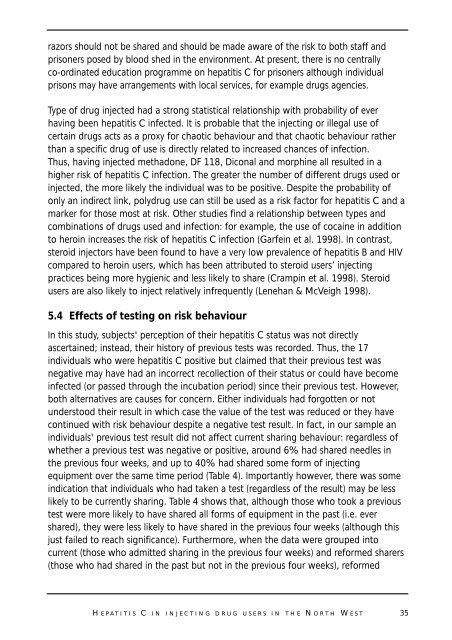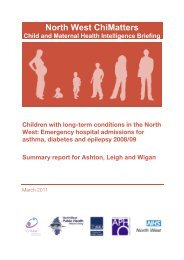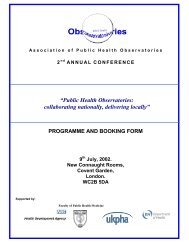9261 HEPATITIS C REPORT GALLEY - North West Public Health ...
9261 HEPATITIS C REPORT GALLEY - North West Public Health ...
9261 HEPATITIS C REPORT GALLEY - North West Public Health ...
Create successful ePaper yourself
Turn your PDF publications into a flip-book with our unique Google optimized e-Paper software.
azors should not be shared and should be made aware of the risk to both staff and<br />
prisoners posed by blood shed in the environment. At present, there is no centrally<br />
co-ordinated education programme on hepatitis C for prisoners although individual<br />
prisons may have arrangements with local services, for example drugs agencies.<br />
Type of drug injected had a strong statistical relationship with probability of ever<br />
having been hepatitis C infected. It is probable that the injecting or illegal use of<br />
certain drugs acts as a proxy for chaotic behaviour and that chaotic behaviour rather<br />
than a specific drug of use is directly related to increased chances of infection.<br />
Thus, having injected methadone, DF 118, Diconal and morphine all resulted in a<br />
higher risk of hepatitis C infection. The greater the number of different drugs used or<br />
injected, the more likely the individual was to be positive. Despite the probability of<br />
only an indirect link, polydrug use can still be used as a risk factor for hepatitis C and a<br />
marker for those most at risk. Other studies find a relationship between types and<br />
combinations of drugs used and infection: for example, the use of cocaine in addition<br />
to heroin increases the risk of hepatitis C infection (Garfein et al. 1998). In contrast,<br />
steroid injectors have been found to have a very low prevalence of hepatitis B and HIV<br />
compared to heroin users, which has been attributed to steroid users’ injecting<br />
practices being more hygienic and less likely to share (Crampin et al. 1998). Steroid<br />
users are also likely to inject relatively infrequently (Lenehan & McVeigh 1998).<br />
5.4 Effects of testing on risk behaviour<br />
In this study, subjects' perception of their hepatitis C status was not directly<br />
ascertained; instead, their history of previous tests was recorded. Thus, the 17<br />
individuals who were hepatitis C positive but claimed that their previous test was<br />
negative may have had an incorrect recollection of their status or could have become<br />
infected (or passed through the incubation period) since their previous test. However,<br />
both alternatives are causes for concern. Either individuals had forgotten or not<br />
understood their result in which case the value of the test was reduced or they have<br />
continued with risk behaviour despite a negative test result. In fact, in our sample an<br />
individuals' previous test result did not affect current sharing behaviour: regardless of<br />
whether a previous test was negative or positive, around 6% had shared needles in<br />
the previous four weeks, and up to 40% had shared some form of injecting<br />
equipment over the same time period (Table 4). Importantly however, there was some<br />
indication that individuals who had taken a test (regardless of the result) may be less<br />
likely to be currently sharing. Table 4 shows that, although those who took a previous<br />
test were more likely to have shared all forms of equipment in the past (i.e. ever<br />
shared), they were less likely to have shared in the previous four weeks (although this<br />
just failed to reach significance). Furthermore, when the data were grouped into<br />
current (those who admitted sharing in the previous four weeks) and reformed sharers<br />
(those who had shared in the past but not in the previous four weeks), reformed<br />
H EPATITIS C IN INJECTING DRUG USERS IN THE N ORTH W EST 35











